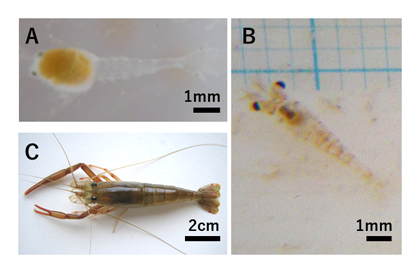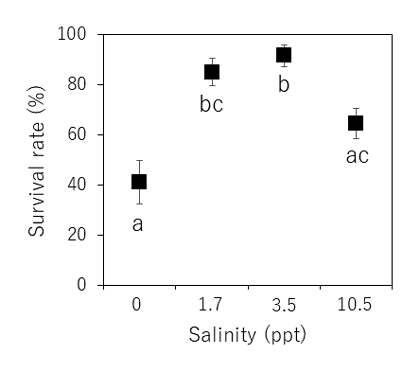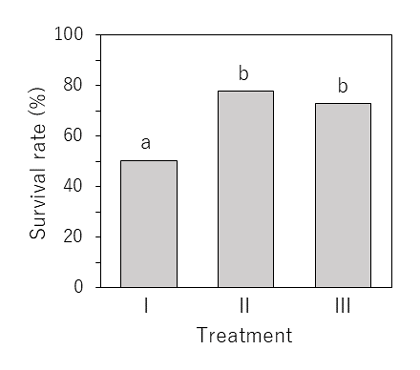Development of a rearing technique for the free-swimming zoea larvae of the freshwater shrimp Macrobrachium yui from Northern Laos
Description
In Laos, many freshwater prawns (Macrobrachium spp.) have been found in a variety of freshwater environments including rivers, ponds, and caves. They have high market value and thus are economically important for the local farmers. Macrobrachium yui (Holthuis 1950, Fig. 1), which mainly inhabits the northern part of Laos, fetches the highest price at the local market. The females of M. yui have been reported to migrate toward the inner part of the cave stream to spawn and hatch their eggs. After the zoea larvae hatch out (Fig. 1A), they stay inside the cave until development into postlarvae (Fig. 1B). Then, they change their habitat from the cave stream to the aboveground river and develop into juveniles. Thus, this species inhabits two different water environments in its life cycle. In Laos, M. yui catch has decreased dramatically, and the genetic diversity in some local populations has already been greatly reduced by environmental deterioration and overfishing. In order to aid in conserving and recovering local populations of M. yui, production of M. yui larvae may be one promising solution. In this study, we aimed to develop a technique for rearing M. yui larvae without using cave stream water.
According to the relationship between egg size and salinity tolerance of larvae of the Macrobrachium species, it was hypothesized that (1) the larvae of M. yui can develop at a certain water salinity during zoea larvae stage and (2) they can adapt to freshwater after development into postlarvae. We compared the survival rate of the zoea larvae when reared in 4 different salinities (0-10.5 ppt). Among the tested waters, the zoea larvae showed the highest survival rate, at 91.7 % on average, in 3.5 ppt (Fig. 2). Next, we tested acclimation to freshwater during the postlarval stage using three experimental treatments: rearing at 0 ppt salinity (freshwater) for both the first and second weeks (treatment I), rearing at 1.7 ppt for the first week and 0 ppt for the second week (treatment II), and rearing at 3.5 ppt salinity for both the first and second weeks (treatment III). The postlarvae survived better in treatments II (78%) and III (73%) than in treatment I (51%) (Fig. 3). Finally, the water from the Xuang river in Luang Prabang Province, Laos, where M. yui inhabits, was analyzed using ion chromatography to know ion concentrations. The concentrations of SO42−, Mg2+, and Ca2+ of 3.5 ppt artificial seawater were similar to those in cave water (Table 1).
This study succeeded in rearing zoea larvae of M. yui using 3.5 ppt artificial seawater instead of cave water. The postlarvae showed high survival rates when rearing salinities were gradually decreased. The technique developed in this study will contribute to artificial seed production of M. yui in aquaculture facilities without cave water, and help in recovery efforts for the endangered local populations of M. yui.
Figure, table
-
Fig. 1. The developmental stages of M. yui.
A: Hatched larva
B: Postlarva
C: Female broodstock -
Fig. 2. Survival rates of larvae during the free-swimming zoea larval stages when reared at 4 different (0-10.5 ppt) salinities.
The results are expressed as the mean ± SE of 23 replicates. Different letters indicate significant differences (P < 0.05). -
Fig. 3. Survival rates of postlarvae during the 2 weeks after settling to the bottom, in three treatment groups.
Treatment I: n = 93, 100, and 107 in Treatment I, II, and III, respectively. Different letters indicate significant differences (P < 0.01). -
Table 1. The concentration (mg/l) of major ions in 3.5 ppt artificial seawater, cave stream water, and aboveground water. The U and P values indicate statistical results of the comparison of seven ions between cave stream water and aboveground water by the Mann-Whitney U test. IonsArtificial seawater at 3.5ppt*Cave stream water (n=4) (mean (SE))Aboveground water (n=12) (mean (SE))U valueP valueCl-1767.91.04(0.14)0.34(0.12)530.025NO3-N.D.**2.06(0.63)0.19(0.06)570.006SO42-270.467.48(46.88)9.52(3.96)520.034Na+1053.96.34(0.46)8.85(1.33)280.505K+41.50.68(0.06)1.07(0.09)120.009Mg2+134.916.61(3.60)8.49(1.48)530.025Ca2+62.5108.28(4.80)41.18(5.12)580.004*Kester et al., (1967) Limnol. Oceanogr., 12: 176-179.
**N.D., no data
- Affiliation
-
Japan International Research Center for Agricultural Sciences Fisheries Division
- Research project
- Program name
- Term of research
-
FY2017(2011~2015)
- Responsible researcher
-
Okutsu Tomoyuki ( Fisheries Division )
KAKEN Researcher No.: 40456322Morioka Shinsuke ( Fisheries Division )
KAKEN Researcher No.: 40455259Ito Sayaka ( Japan Fisheries Research and Education Agency )
Hamada Koji ( Institute for Rural Engineering, NARO )
Chanthasone Phonenaphet ( Living Aquatic Resources Research Center )
Kounthongbang Aloun ( Living Aquatic Resources Research Center, Lao PDR )
Phommachan Phoutsamone ( Living Aquatic Resources Research Center )
Lasasimma Oulaytham ( Living Aquatic Resources Research Center, Lao PDR )
- ほか
- Publication, etc.
-
https://doi.org/10.1007/s10499-017-0218-y
Okutsu T et al. (2017) Aquaculture International, 26:325-335
- Japanese PDF
-
A4 282.25 KB
A3 278.58 KB
- English PDF
-
A4 172.78 KB
A3 149.44 KB
- Poster PDF
-
2017_C04_poster.pdf359.46 KB



